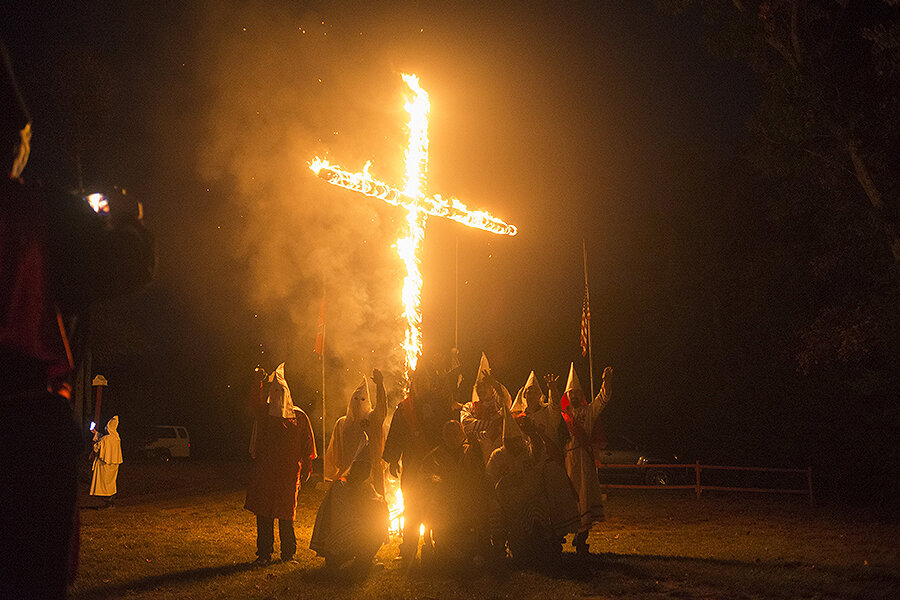Anonymous launches 2nd cyberwar on KKK
Loading...
Has vigilante justice come full circle?
For 150 years, the Ku Klux Klan, which keeps its membership rolls secret, has been near-synonymous with terror and hatred in America, even as membership sputters at all-time lows.
The hate group is down to a few thousand today, a far cry from the 4 to 7 million who powered the Klan's campaigns in the early twentieth century, an era when, in some towns, membership was hardly a secret.
Now, the identities of Klan members may again become public, as the shadowy, decentralized hacking group Anonymous has announced plans to reveal the names of 1,000 members.
"After closely observing so many of you for so very long, we feel confident that applying transparency to your organizational cells is the right, just, appropriate and only course of action," Anonymous said in a press release Tuesday.
Anonymous leaked the name of a North Carolina woman the group claims is a Klan member on October 24, alongside her address, email, and phone number. They plan to reveal the remaining identities in November, to mark the anniversary of their first #HoodsOff campaign, or #OpKKK: a response to the KKK's promise to use "lethal force" if threatened by protestors in the wake of Michael Brown's shooting in Ferguson, Mo.
Anonymous claimed to have hacked KKK Twitter accounts and websites, promptly shutting them down, but earned strong condemnation for leaking the name of the policeman who supposedly shot Michael Brown before it was announced by St. Louis police.
Except that it was the wrong name.
Bryan Willman, a police dispatcher in St. Ann, Mo. hid at home as hundreds of death threats poured in. In fact, he'd never even been to Ferguson, according to the New Yorker's David Kushner.
It was not the only time Anonymous has misidentified an enemy, the type of error that makes some activists feel uneasy about the group's web vigilantism, even when the target is a part of a group as widely condemned as the KKK.
Anonymous's tactics have not veered into real-life violence, but the consequences of their "doxxing," as they call a public ID, can be dangerous.
The #HoodsOff press release makes clear that Anonymous isn't attacking because of the KKK's racism; one thing both groups have in common is a zealous love of free speech:
We are not oppressing you, Ku Klux Klan. We are not here to strip you of your Freedom of Speech. Anonymous will never strip you of any of your Constitutional rights ... We are stripping you of your anonymity. Again. This is our protected speech.
Anonymous has an long list of targets, and accomplishments. Members have posed as underage girls to catch pedophiles online, for instance.
"They tend to fight for things most of us support: privacy online, freedom of expression, government transparency," Jamie Bartlett wrote in a review of "Hacker, Hoaxer, Whistleblower, Spy," Gabriella Coleman's in-depth account of the sprawling organization. Those aims sometimes win praise: several times, for instance, members have posed as underage girls to catch pedophiles online.
But Mr. Bartlett also contends that "too little attention is given to the way they trample over others to get there."
Ever since its murky inception, Anonymous's lack of leadership has helped it escape censure, but also fed conflicts between immature jokers, committed idealists, and dangerous threats that led to the moniker "Internet hate machine."
Some observers suggest that its renewed fight with the KKK is just as much about personal threats to a member as a broader social justice movement.
"You messed with our family and now we will mess with yours," one of its recent press releases says.
Another book about 'anons,' Parmy Olson's "We Are Anonymous," led New York Times reviewer Janet Maslin to conclude "they confirm the worst suspicions about the power of sophisticated but untethered Internet manipulation."
As evidence, she cites Ms. Olson's conversation with one obviously pseudonymed "William."
"You could inspire some 15-year-old, or someone with a 15-year-old's mind-set, to hate whoever you want them to hate," he bragged.
In #OpKKK, Round 2, will Anonymous's better instincts prevail?
"When people are faced with grave injustices, those cries do not go unheard," it promises the KKK.








